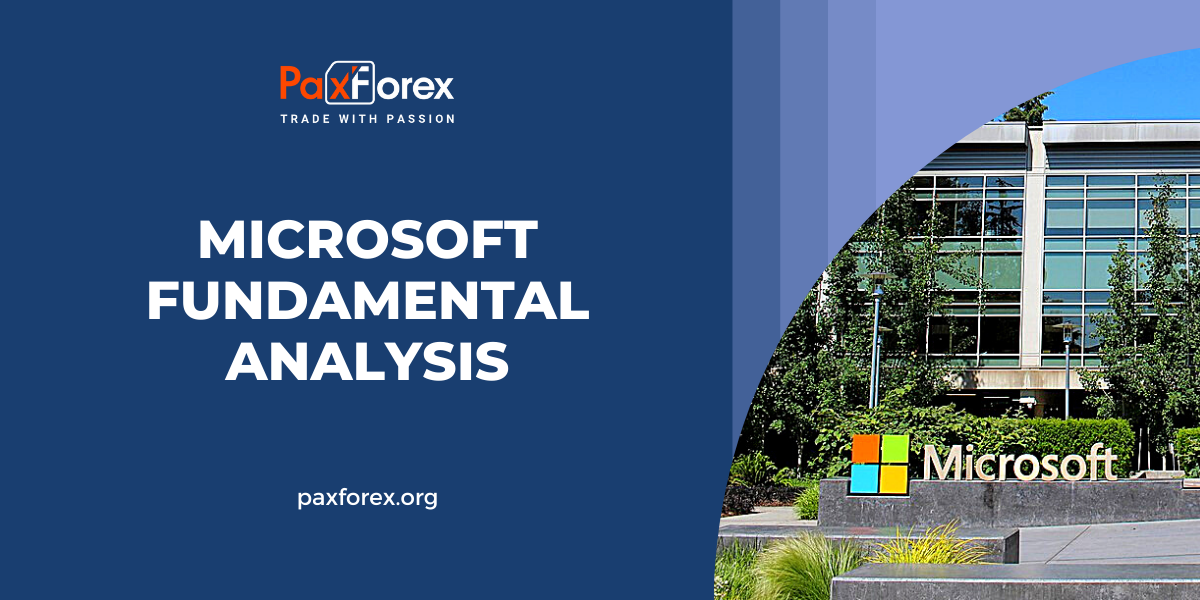
Source: PaxForex Premium Analytics Portal, Fundamental Insight
When Satya Nadella assumed the role of CEO at Microsoft in 2014, the company's value stood at approximately $300 billion. Under Nadella's leadership, the tech giant experienced remarkable growth, tripling its value to reach $1 trillion in 2019 and subsequently doubling its market capitalization to $2 trillion in 2021. As of today, Microsoft is valued at $2.5 trillion.
Considering this impressive trajectory, there is speculation that Microsoft could potentially become a $3 trillion company in the near future. However, the question arises as to whether it could double its value yet again and become a $5 trillion company by the end of the decade. To make an informed judgment, let's examine the company's recent growth trends, upcoming catalysts, and valuations.
Satya Nadella's tenure witnessed Microsoft's market value soar due to three key factors. Firstly, the company expanded its Azure cloud infrastructure platform while transitioning its traditional desktop-based applications into subscription-based cloud services. This strategic move allowed Microsoft to tap into the burgeoning market for cloud computing. Secondly, Microsoft made the decision to discontinue its Windows Phone and instead introduced versions of its productivity software for iOS and Android, expanding its reach across multiple platforms.
Lastly, Microsoft bolstered its ecosystem through strategic acquisitions of prominent companies such as Mojang, LinkedIn, GitHub, Affirmed Networks, Zenimax Media, and Nuance Communications. Additionally, Microsoft recently announced its plans to acquire the gaming giant Activision Blizzard, although the completion of this significant deal is subject to regulatory approval.
Examining the financial performance of Microsoft, between fiscal years 2014 and 2022 (concluding in July), the company's total revenue exhibited a compound annual growth rate (CAGR) of 11%, climbing from $86.8 billion to $198.3 billion. Notably, its earnings per share (EPS) experienced an even higher CAGR of 18%.
Taking into account these factors, the question of whether Microsoft can attain a market value of $5 trillion by the end of the decade remains open. While the company has demonstrated substantial growth and innovation under Nadella's leadership, achieving such a milestone would require sustained expansion, continued market dominance, and the successful integration of its acquisitions.
Initially, Microsoft's foray into cloud-based services had a margin-squeezing effect. However, as Azure solidified its position as the world's second-largest cloud infrastructure platform after Amazon Web Services (AWS), economies of scale came into play. According to Canalys, by the end of 2022, Azure held a 23% share of the global cloud infrastructure market, with AWS leading at 32%, and Alphabet's Google Cloud Platform (GCP) at 10%.
Looking ahead, Microsoft's growth trajectory will hinge on several factors. First, the ongoing expansion of its cloud ecosystem will be crucial. Additionally, the company's ability to maintain growth on iOS and Android through mobile apps, transform the Xbox console into a cloud-based gaming service, and expand its "generative AI" services through investments in ChatGPT will be key drivers.
According to Fortune Business Insights, the cloud computing market is projected to grow at a compound annual growth rate (CAGR) of 20% from 2023 to 2030. If Microsoft keeps pace with this growth rate, its annual cloud revenues could nearly quadruple from fiscal year 2023 to fiscal year 2030. The expansion of Microsoft's productivity apps on iOS and Android, which integrate users with its cloud-based services, is likely to complement this growth.
In 2020, Microsoft introduced its Xbox Cloud Gaming service, which reportedly garnered over 13.2 million players by the end of 2021. This figure represents more than half of the 21.8 million Xbox Series S and X consoles sold since late 2020, as well as over half of the 25 million Xbox Game Pass subscribers as of January 2022.
By integrating its Xbox Game Pass and Cloud Gaming services, Microsoft has the potential to gradually transition from low-margin consoles to a high-margin cloud-based gaming service. This shift would allow subscribers to play games on various low-end devices. Microsoft's interest in acquiring Activision Blizzard aligns with this strategy, but regulatory authorities are closely scrutinizing the deal due to antitrust concerns. The cloud gaming market is projected to experience substantial growth, with Fortune Business Insights estimating a remarkable CAGR of 47% from 2023 to 2030. Consequently, this division could serve as a new growth engine for Microsoft.
Additionally, Microsoft's significant investments in OpenAI, the company behind generative AI technologies like ChatGPT and DALL-E, are noteworthy. Microsoft has already integrated ChatGPT into its Bing search engine and Azure cloud services while utilizing DALL-E for its Bing Image Creator to generate AI-generated images. These strategic moves position Microsoft favorably in the emerging generative AI market, projected to grow at a CAGR of 36% from 2023 to 2030, according to Reportlinker.
Considering these factors, a conservative estimate suggests that Microsoft could achieve a compound annual growth rate (CAGR) of 10% in revenue and earnings per share (EPS) from fiscal year 2022 to fiscal year 2030. Under this projection, Microsoft's revenue would more than double from $198 billion in fiscal year 2022 to $425 billion in fiscal year 2030, while its EPS would also more than double from $9.65 to $20.70.
Assuming stable valuations, this growth trajectory indicates that Microsoft's market capitalization could double from its current value of $2.5 trillion to $5 trillion by the end of the decade. Although not as remarkable as the company's 583% gain over the past seven years, it would still represent a substantial return for one of the world's largest technology companies.
As long as the price is above 325.00, follow the recommendations below:
- Time frame: D1
- Recommendation: long position
- Entry point: 338.13
- Take Profit 1: 350.00
- Take Profit 2: 370.00
Alternative scenario:
If the level of 325.00 is broken-down, follow the recommendations below:
- Time frame: D1
- Recommendation: short position
- Entry point: 325.00
- Take Profit 1: 315.00
- Take Profit 2: 300.00













